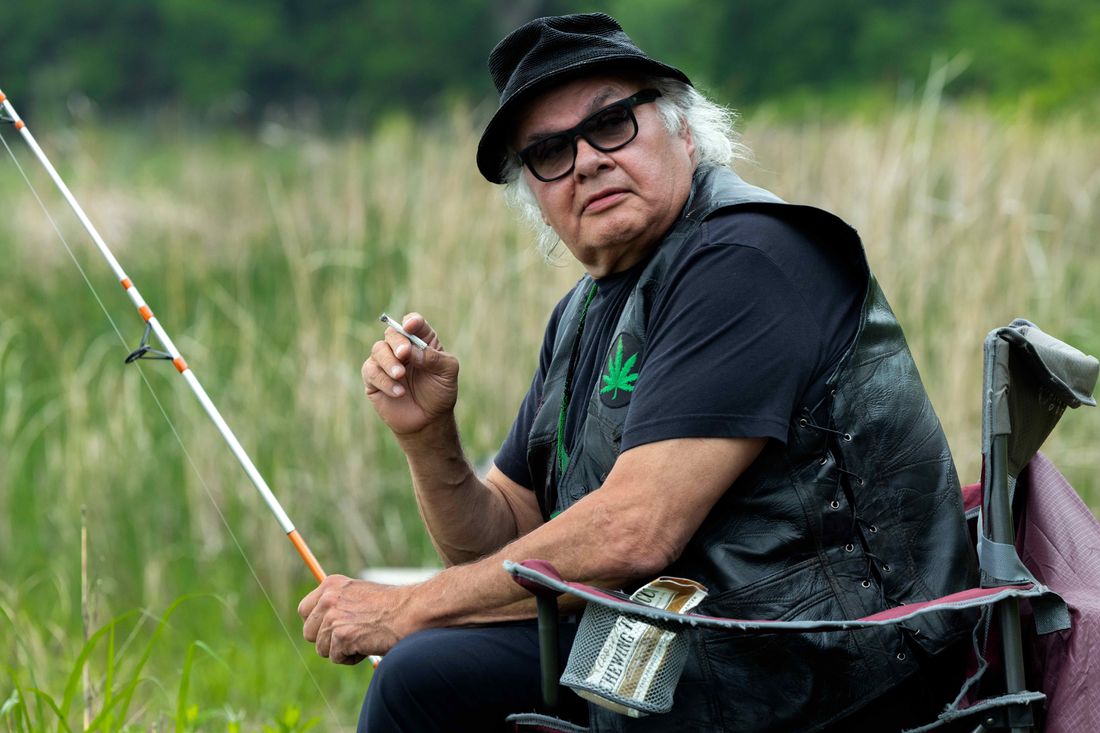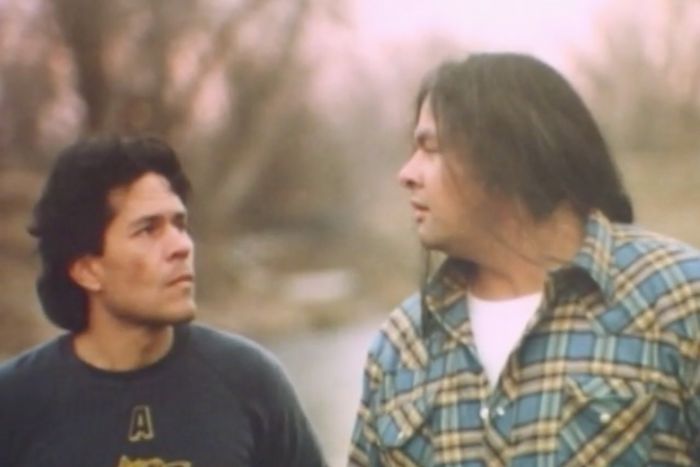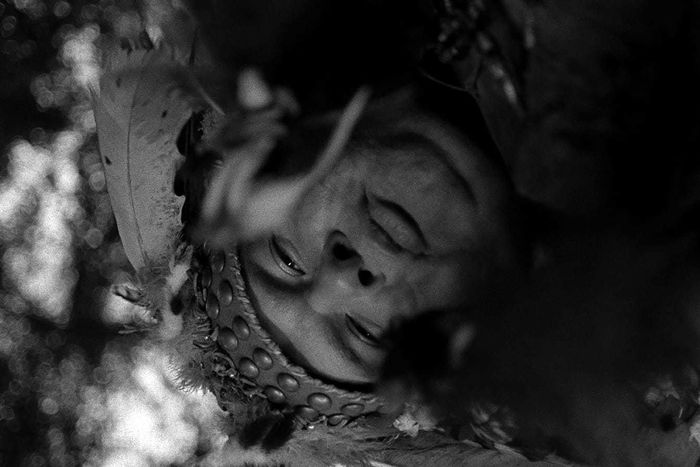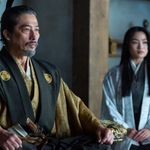
Much like Uncle Brownie, the shambling, warmhearted eccentric he played for three seasons on Sterlin Harjo’s Reservation Dogs, Gary Farmer takes the long view of things and rarely turns down the chance to be funny about it. Even when the occasion is as somber as a funeral — like the send-off for Dogs itself — Brownie’s droll one-liners and stealthy bits of wisdom, delivered via his signature stoner deadpan, pierce the gloom. It’s a role honed from decades of stage and screen work, including counterculture-coded wanderers in Smoke Signals, Powwow Highway, and Sioux City and the gnomic and grimly funny Nobody in Jim Jarmusch’s Dead Man and Ghost Dog: The Way of the Samurai.
Now 70, Farmer is a legendary figure among North America’s Native artists and entertainers. Born into the Cayuga Nation and Wolf Clan of the Haudenosaunee/Iroquois Confederacy, he grew up in Buffalo, New York, where his father operated a construction crane, and started acting in the mid-1970s, when roles for Indigenous actors were scarce. Farmer and other Native performers of his generation created their own opportunities: writing, directing, producing, and performing in plays and independent films; agitating for less stereotyping in non-Native stories; and organizing to enrich and protect their communities. Reservation Dogs could represent the culmination of efforts of artists like Farmer, but he sees it as just one marker on a timeline that started long before he entered the world and will continue after everyone reading this interview has passed on. He’s done his job, and now it’s time to pass the baton. “For me, it’s always been about developing new stories from our perspective, developing new stories from the ground up with communities — a group of people and a writer or a table full of writers,” says Farmer. “And you know what? It worked. I used to produce. I used to direct. Now I get to sit back and just be the actor.”
When somebody says the title Reservation Dogs, what’s the first thing you think about?
We didn’t know. Nobody really knew.
Knew what? How important it would be?
Yeah! All those people on the creative side of the show are going to be employed for a long time. I don’t know if anything will replace Reservation Dogs, but that creative team has gone into the bigger world to do bigger things.
Was there any talk about keeping the show going?
Sterlin said if he did do a fourth season, he’d want to set it in the 1970s — which you think the network would have gone for, because they would have hired new actors and they could all start from year one at base pay, you know? [Laughs.] But the networks just didn’t buy in.
Are you bummed about that?
Life goes on. It was a sweet part, and probably my most recognizable character ever. I mean, I make jokes about 18-year-old white waitresses realizing, “It’s Uncle Brownie!” I never had that audience, you know? I’ve always had a Native American following. But this has opened me up to a much larger world, a more BIPOC audience, I could say, as well as the mainstream community that has acknowledged this show, even though the Whatever Foreign Press didn’t.
I was surprised we didn’t get one nod from them for Rez Dogs, especially when I saw that this show The Curse, with Emma Stone — which I’m on two episodes of, playing a pretty straight character — got a nod from them. It’s a pretty out-there show, and God bless Emma Stone, but I thought if they were gonna get some recognition, our show should have gotten at least a nod for its final season. But that’s that.
It’s incredible looking back over everything you’ve done. There are so many connection points with other major performers from many generations. For instance, Lily Gladstone made her film debut in a movie you co-starred in, Jimmy P., by the French director Arnaud Desplechin, which was subtitled Psychotherapy of a Plains Indian.
That’s right! It was nice to finally meet Benicio Del Toro after all those years of watching him. He beat me out in that great awards thing. You know the one? The one they started off down on the Santa Monica beach? The Independent Spirit Awards? I’m not sure what they call it anymore.
They still call it the Spirit Awards!
Okay, good. It’s always held the night before the Academy Awards, right? It was a great event. So many great independent films got recognition. Many of them, of course, went on to the Oscars as well. The Independent Spirit Awards was the closest I ever got to the hoopla that Lily will enjoy this coming awards season.
Have you seen Killers of the Flower Moon?
I love Lily, and she’s a dear friend, and I’ve worked with Robert De Niro. I don’t know, I’m just … maybe I’ll see it eventually. It means the world to the community and to all of our nations here in America and Canada and Mexico, and I’m happy for all the attention it’s been getting. But I don’t need to see us murdered 20 times before the credits. Been there, done that, you know? I think the young actress from our show, Devery Jacobs, who plays Elora, was right: She made some observations about that movie on social media which were pretty hard and scathing.
She wrote, “Imagine the worst atrocities committed against [your] ancestors, then having to sit through a movie explicitly filled with them, with the only respite being 30-minute-long scenes of murderous white guys talking about/planning the killings.”
I think a lot of us felt like what she wrote made sense. The film is not us telling the story. I’ve been promoting a book by Linda Hogan, who’s Achocta [Chickasaw]. She wrote a book called Mean Spirit, back in 1990, that tells the same story as the movie and the nonfiction book it was based on! Thirty-three years ago, right? I’ve been talking this book up for 33 years! We are always looking for stories to tell as a Native community or as Native actors, and her novel seemed like a perfect one to tell. But if you’ve got a book written about it from a different perspective that was published two years ago or something, well, that book gets made, and not this earlier one by our own creative people. So anyway, no, I haven’t seen Killers of the Flower Moon.
Are there ever times when you think, I wish I could do more parts where I play one little cog in the story, like white actors have the privilege of doing, and not feel the pressure of having to accurately represent some aspect of the Native experience?
When I decided to be an actor, it was because I had seen the power of theater and how the actor can manipulate stories and pull powerful emotions out of people. I became an actor because I thought, I want to help my people, and how am I going to do that? Am I going to be a cop? That’s certainly not going to help. Am I going to be a social worker? I don’t know. Maybe a lawyer? Once I discovered the theater, I just knew. Oh, this is how I do it. I started acting at 20 and I never turned back.
You were in a lot of movies in the late ’80s and early ’90s that were important for Indigenous actors and filmmakers. You were in Dark Wind, the mystery thriller, based on Tony Hillerman’s novel.
I get a small residual from that now because once the Dark Winds series came on, people started looking at the movie again, which was great.
And there was the triptych of Powwow Highway, Smoke Signals, and Sioux City within the space of just five years. The character you play in Powwow Highway, Philbert Bono, starts his journey by trading weed for a “war pony,” which is actually a Buick Wildcat, so he can go on a vision quest and thwart some strip miners. Watching it again before talking to you, I thought, Wow, this is like a plot out of Reservation Dogs!
Yeah, that was Powwow Highway! Set in Lame Deer, up in Montana! Jonathan Wacks directed it and Peter McCarthy produced it. They did Repo Man together. I think that was Jonathan’s directorial debut. It was co-written by David Seals, who wrote the novel it was based on, and Janet Heaney and Jean Stawarz, who had never even been to Lame Deer. One of them, I married: Jean Stawarz. She ended up teaching screenwriting at Emerson College and is still on the faculty there.
Working on that film was a wonderful journey. When I got there, not one person on that crew, including the director, had ever been to an Indian reservation! I couldn’t get them to go to the powwow the community was hosting while we were there because they all felt too bad about the living conditions in northern Cheyenne at the time, which was unlike any other reservation in the country, really — a little more northern, a little more isolated, with an amazing survival history, those people. It changed my life, that film — artistically but also personally, because of the growth I experienced from engaging in that culture for those two months we were shooting. I met people I’m still dear friends with. I’m still in touch with Jonathan, and A Martinez and I are as close as ever. A lot of those actors are gone now, of course. It was certainly an important film. It won the Audience Award at Sundance. I wasn’t there for the ceremony because I was busy developing a new play that turned out to be the most profitable thing I’ve ever been involved in.
What was the play?
Dry Lips Oughta Move to Kapuskasing, by Tomson Highway.
Tell me about that.
We came up together. Tomson is a classical pianist and his brother was a modern dancer. I was a photographer when we met. Tomson brought us to the Shaw Festival, which is a big-time event in Toronto. I captured it with photography. I had to play Pontiac from 1796 in a play — the real character of Pontiac, the Odawa leader who fought heartily to maintain his position. Tomson did the Cree part of my speech. It was the first time they brought Indigenous language to a play. I played sax in the halls of this beautiful old theater that must have had 300 seats, a theater in the round. It was just a beautiful time, you know?
And then Tomson started to write his own plays. First it was a small piece for his brother, then he wrote this powerful play called Rez Sisters that went around the world, and then he wrote Dry Lips Oughta Move to Kapuskasing, which is about seven men and this trickster character who’s a woman. It put theater on its nose in Canada when we put it on in 1989. We took most of the awards, and then it won the Governor General’s Award for playwriting. It toured the whole country and went off to Scotland for a big theater festival and even got around the world some. It still gets picked up. It’s a powerful piece. You laugh your ass off in the first act, and then it slaps you around in the second act. It just works so well.
And he’s such a verbose, quadrilingual dude, Tomson — he’s quite a character. I just caught up with him; we might do some of his new work coming up this year, maybe. We’ll see. We’re both getting up there, but I’ve spent a life performing his plays, and several companies developed out of that. Much of the senior actors came up through that system. The theater scene is a lot more prolific in Native communities in Canada because we don’t fight wars every day. There’s more money for the arts generally than there is here.
Tell me about working with the great actor Graham Greene, who acted with you in Dry Lips Oughta Move to Kapuskasing and played Maximus on Reservation Dogs. That’s quite a time span!
My grandmother and Graham’s father are first cousins. I was in the States mostly, but I’d go back to stay at my grandmother’s home. Graham was across the street from us with, like, eight brothers and sisters. We’d known each other since we were children. I was the only child for about eight years. I used to get all these gifts and Graham didn’t get much, so he’d come and play with all the shit I got, and that’s how we got close! We ended up in the same rehearsal halls just by chance. I think he started acting just a bit before me — I started in ’75, he might have started in ’73 or so. But we’d been pals for years before that. He used to be a road man, doing sound and lights for some really popular Canadian musical acts. We used to trip around, and of course Canada closes at 1 a.m. or whatever and we were still out there hustling, so we’d drive down to Buffalo, and Graham would imitate Jesse Ed Davis, the Kiowa guitar player who played with the Beatles, so we could get into clubs down there.
You’ve also worked more than once with other Reservation Dogs cast mates of your generation, including Wes Studi, who was also in Powwow Highway.
Yeah, that was Wes’s first movie appearance. I went to L.A. after that for a bit because, as I said, I had fallen in love with one of the screenwriters of the movie, and she was there, so I used to hang out with Wesley, too. In L.A. I got to teach an acting class through the American Indian Registry. The thing I got the most from it was that studying acting was scene studies. You just match people up as partners and get them to work the scene, you know? Well, all those guys from Oklahoma, they were always very manly, right? Usually you rehearse the scene before you come back again so you got something to present with your partner, but I could never get those Oklahoma Indians to get down and do the work. They’d just come and watch, then they’d get up there with no rehearsal!
But, yeah, I’ve known Wes for years. In fact, I was just thinking about calling Wes today to help me with my pipe. He used to make traditional pipes for us, and I’ve got a stone I’ve been working on, so I’m hoping he can make me a new prayer pipe.
Let’s talk about Jim Jarmusch’s Dead Man, the first English-language film to have Indigenous characters speaking untranslated Cree and Blackfoot. That gave you a character, the spirit guide Nobody, that you played in that film and then Ghost Dog: Way of the Samurai.
There’s a lot I got from Dead Man. I’ll never forget it. I learned so much about myself. Jim and I would have these wonderful discussions about the script and get into questions like, “Don’t the meek inherit the Earth?”
You didn’t want Nobody to die in that movie, right?
I get so into the story when I do these things! You gotta learn when to let go and when to hold up for something you believe in. But, you know, Jim’s such a sensitive guy, and a few years later he goes, “Hey Gary, you were right! I’m gonna put you in Ghost Dog and show ’em that Nobody’s still alive!” We had a wonderful relationship through that one character. I think Nobody’s gonna come back once more, if we both live long enough to do it. There are so many things about that experience that seem incredible to me. There’s the fact of it being Robert Mitchum’s last movie appearance, and the fact of just being in that cast and getting to meet a lot of those performers and hang out. And Jim! He’s like a relative. We stay in touch. We don’t yuk it up as much as we used to, because we’re getting older.
You know, Harvey Weinstein is the one that killed the distribution of that movie throughout America. Dead Man was a movie Jim hoped would play wide but ended up on an art-house tour.
What happened?
Harvey wanted Jim to cut the movie, and Jim refused. He owned the movie and he’d already signed a contract with Harvey saying Miramax was releasing a finished movie and it didn’t have to be cut. So Harvey dumped it. That Dead Man only played art houses in the States killed the film for Jim — economically, certainly. It cost a lot to make by his standards. Jim funded it independently from, I think, Europe and Asia mainly. There was a certain bitterness after that, about the fact that Dead Man didn’t get a better run. But it’s still highly recognized to this day, and it went on to be respected in the academic world, and to become the first American film to win the Screen International Five Continents Award from the European Film Awards. Jim couldn’t go to the ceremony. He sent Johnny Depp and me and Robby Müller, the cinematographer. We had a great time in Berlin. Gandhi gave us the award. Well, not the real Gandhi. The guy who played him. What’s his name?
Ben Kingsley.
[Laughs.] Ben Kingsley! You know, after Dead Man, Johnny originally wanted me to play Doctor Gonzo in Fear and Loathing in Las Vegas.
Which Benecio Del Toro ended up playing!
It was good, though — Johnny even introduced me to Hunter S. Thompson. And I had a great relationship with Neil Young after Dead Man. Not long after that, I was trying to develop a national radio system for Native people in Canada. I was at the forefront of that battle when Neil did a fundraiser for us and some other organizations in San Francisco.
I told Jim before we started Dead Man, “Hey, let’s do this story contemporary — like, now! Because that’s my life, you know?” The character of Nobody was abducted as a child and taken to Europe by Europeans. I was the only Indian in an immigrant school in Buffalo. I work there a lot still, in Buffalo, with the Native community. My people are all there because our rezes are on both sides of the border: the Haudenosaunee of the Iroquois. That border has never meant anything to us — hey, wanna hear something great? In 2028, lacrosse is going to be in the Summer Olympics. The Haudenosaunee have our own team, the Haudenosaunee Nationals, and we’ll get to represent our nationhood at the Olympics for the first time! We still don’t get any respect politically, though. It’s been a hard run for our communities, with all these strategies that try to undermine anything we do economically in order to better ourselves. It’s been an uphill battle, even down to basics like infrastructure for water. So I’ve always looked at the kind of work I do as an actor as part of a bigger picture. It certainly serves a purpose to retell American history from a Native perspective.
That’s why it was so great to hang out with the cast and crew on Rez Dogs. They’re a pretty interesting batch of people. I think the show inspired a lot of actors, too. That’s been the basis of my work, to try to inspire people. I needed inspiration coming up. I’m so unique, you know? First, by being a Native actor. Plus, I’m big. Everybody else on a film set is probably gonna be five-foot-eight, five-foot-nine, around that height, maybe a little taller. I’m six-foot-three and 270 pounds. They used to tell me I ate up the screen. That made it hard to get work. It’s been a hard road, you know? As I look back on everything, it seems to me that having a career at all is pretty special in itself.
What are you working on right now?
I just finished shooting in L.A. It’s an interesting little short film by a young Miccosukee tribal member, Montana Cypress. He does theater, too. Montana is a little off-the-beaten-path kind of guy. He doesn’t seem to fit into the norms. I like supporting his artistic nature, though. There were 16 pages of dialogue and I had a five-page speech, so it was challenging, but I whipped it and I felt really good about it. I play an old, dying dog who’s about to get euthanized. And I did manage to get Tantoo Cardinal involved. She kind of plays opposite me. Tantoo and I were both on Spirit Bay, which started in 1982. We also did a TV movie together in 1985, Where the Heart Is, for the CBC series For the Record, which was about social issues. It was a story about Bill C-31. Do you know it?
No, please tell me.
Tantoo played a woman who divorces her white husband and finds out she lost her Native status as a result of the divorce. In Ontario, women who were married off to another tribe lost their status as Native people. There were other ways somebody could lose their status. The bill was about trying to stop that kind of thing from happening, to amend the Indian Act and bring it in line with gender equality according to the Canadian Charter of Rights and Freedoms. The passage of that bill was a big win for women.
Eras of oppression and disenfranchisement, I guess, have always befallen us. It’s been interesting to chart the history from my perspective as an actor.
Overall, do you feel like there’s been substantial forward motion in terms of job opportunities and representation?
I don’t know yet. It’s all about who gets out of the gate. I mean, there was Rutherford Falls. But most of the creatives from Reservation Dogs are showrunning or working to tell their own stories. They’re not trying to make another Reservation Dogs. Some of the directors are now in the circle for directing shows that aren’t necessarily Native-themed. Sterlin’s got a paved road ahead of him, you know? He should be okay, right? It seems that anything he touches is gonna turn to gold. Or at least it’ll make audiences think.
What about you?
I’m a 70-year-old actor. I’m on the tail end of a wonderful career. I’m still able to work, and I’m counting on Resident Alien getting renewed next year! We got stopped because of the strike and we were supposed to air in August, then we were pushed to November. Now it’s coming out in January, so we won’t know about being renewed until maybe March. And then six months later … you know, I could be starving to death by then. I gotta start from the ground up again as a working actor. It’s been my life, though. I’m used to that.







